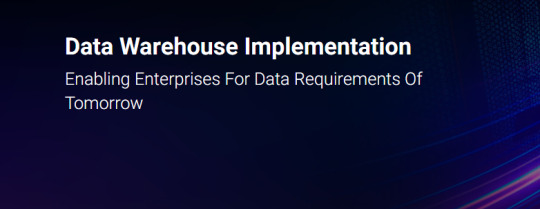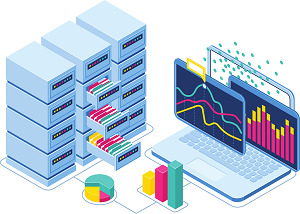#data lake implementation
Explore tagged Tumblr posts
Text

0 notes
Text
https://www.atgeirsolutions.com/data-lake-implementations/

To know more visit: https://www.atgeirsolutions.com/datawarehouse-implementations/
#data lake implementation#hadoop data lake implementation#design and build a data warehouse for business intelligence implementation
0 notes
Text
Businesses can use sophisticated data lake setup services from SG Analytics, a reputable market pioneer. Organizations can harness the power of data lakes by utilizing SG Analytics' experience in data management and analytics. Large amounts of organized and unstructured data may be stored and analyzed more easily with the help of a data lake, which acts as a central repository. Businesses may access priceless insights to fuel growth and innovation using SG Analytics' seamless integration, effective data governance, and advanced analytics capabilities. Utilize the comprehensive solutions from SG Analytics to realize the revolutionary potential of data lakes fully. Explore their data management and analytics services right now by visiting their website!
1 note
·
View note
Text
How to Ensure Data Quality and Governance in Your Enterprise Data Lake
In today’s data-driven world, enterprises are continually collecting massive volumes of data from multiple sources to drive decision-making, enhance customer experiences, and stay competitive. An Enterprise Data Lake serves as a central repository for all this raw data, allowing organizations to store data of all types, structured or unstructured, at any scale. However, without Data Governance and Data Quality measures in place, the effectiveness of an Enterprise Data Lake can quickly diminish, leading to inconsistent data, compliance risks, and poor decision-making.
For more information, visit Teklink International LLC
0 notes
Text
Unlocking the Power of Data Lake Implementation Services

Understanding Data Lakes
Before delving into Data Lake Implementation Services, it’s essential to understand what a Data Lake is. A Data Lake is a centralized repository that allows organizations to store vast amounts of structured and unstructured data in its raw format. Unlike traditional data storage systems, Data Lakes can store data of any type and size, making them highly flexible and scalable.
The Importance of Data Lake Implementation Services
Data Lake Implementation Services encompass a range of activities aimed at designing, building, and managing Data Lakes tailored to the specific needs of organizations. These services offer several benefits, including:
1. Scalability: Data Lake Implementation Services enable organizations to build scalable Data Lakes capable of handling large volumes of data. This scalability ensures that organizations can accommodate growing data needs without compromising performance.
2. Flexibility: With Data Lake Implementation Services, organizations can design Data Lakes that support various data types, including structured, semi-structured, and unstructured data. This flexibility allows organizations to store and analyze diverse data sources efficiently.
3. Data Integration: Data Lake Implementation Services facilitate the integration of data from multiple sources into a single, centralized repository. This integration ensures that organizations have a comprehensive view of their data, enabling better decision-making and analysis.
4. Data Governance: Effective Data Lake Implementation Services incorporate robust data governance frameworks to ensure data quality, security, and compliance. This ensures that organizations can trust the integrity of their data and adhere to regulatory requirements.
5. Advanced Analytics: Data Lake Implementation Services empower organizations to leverage advanced analytics and machine learning capabilities to derive valuable insights from their data. By combining Data Lakes with analytics tools, organizations can uncover hidden patterns, trends, and correlations that drive business growth.

1. Data Architecture Design: This involves designing the overall architecture of the Data Lake, including data ingestion, storage, processing, and access layers.
2. Data Ingestion: Data Lake Implementation Services include mechanisms for ingesting data from various sources, such as databases, streaming platforms, IoT devices, and external data feeds.
3. Data Storage: Data Lake Implementation Services define the storage mechanisms for storing raw and processed data within the Data Lake, such as distributed file systems or cloud storage solutions.
4. Data Processing: Data Lake Implementation Services encompass data processing capabilities for transforming, cleansing, and enriching data within the Data Lake using technologies like Apache Spark or Hadoop.
5. Data Governance and Security: Data Lake Implementation Services include features for implementing data governance policies, access controls, encryption, and compliance measures to ensure data security and regulatory compliance.
Conclusion
Data Lake Implementation Data Engineering Services play a crucial role in helping organizations harness the power of their data effectively. By providing scalable, flexible, and integrated Data Lakes, these services enable organizations to derive actionable insights, drive innovation, and gain a competitive edge in today’s data-driven landscape. As organizations continue to prioritize data-driven decision-making, the demand for Data Lake Implementation Services is expected to grow, making them indispensable for organizations looking to unlock the full potential of their data.
0 notes
Note
What's your take, if you have one, on the cut moon presence boss on the lake of mud?
as always, i dont know. i thought i didn't really have much to say but the more i typed the more i Realized. but i still don't really know lol. this is really image heavy, which made it long, so most of it is under a readmore.
e: hello bea from the future here. hey. this gave me so much to chew on for the next section in a shockingly positive direction. thank you so much for getting this ball rolling
it half-relevant but there's also some kind of. intermediary thing. i think it's the same shape as the used moon presence but its blue. for some reason.

no animations on this one, so it was cut early. different "faces" as well. or the low quality of the cut one doesn't maintain the "features" as accurately.



oh what the fuck. hold on. look at the head of the "lake of mud" (LOM from now on) moon presence compared to the others
ive made posts in the past about anti-clockwise and clockwise metamorphosis runes possibly referencing the in-game phenomenon of creature's heads being turned in odd directions. loran silverbeasts and the crawler enemies (ostensibly both loran/nightmare frontier residents) have their "heads" turned clockwise, like above. slime scholar and probably other things i cant remember turn anti-clockwise.


the crawlers are....i mean they're gross. but also uncanny. there's SOMETHING going on here, right? god only know what though. they are also known for the grim sight you can take in when they rear up to Get You: their...stomach?? is rife with messengers. being consumed? maybe? it evokes the image of the artbook moon presence, who is swarming with messengers in the same area of its body.

anyway back to the little creep.


in the center of its chest there's this bizarre unknown thing. if you peel away the majority of its body it looks like this. a grey blob with tentacles. as far as i can tell it doesn't have bones to animate, unlike the rest of the model. the entire model has unfinished textures so its hard to tell what it's supposed to be.

judging from the blisters on the creature, it is CURSED. the orphan of kos' placenta weapon (which is, i think, just a huge cursed blood gem?) has these same blisters, marking it as a fellow "cursed" great one infant (? probably? look at what a runt it is).
curses are a complex aspect of the bloodborne universe. sometimes they can be identified by the appearance of "sickly spots", but other times, curses are color-coded with purple (or red, but that seems strictly related to cainhurst nope i forgot foetid offering can give enemies red rally auras and change their drop tables to include cursed blood gems. much to think about) auras and magic.

a curse is exactly what you expect it to be: great power at a high price (like a huge weapon bonus but your health depletes per second), but the source is arcane. the cursed and defiled pthumerian chalice states, "curses are caused by inciting the anger of the Great Ones, and used to hex others." winter lanterns, the enemies with the heads made out of messengers fused into a brain shape, are the only enemy that consistently only drops cursed blood gems (and, evidently, blood gems only form in the dungeon or nears its entrances). given the pattern of these spots appearing on bosses, it can be reasonably assumed that winter lanterns are the result of a great one's wrath. what the fuck! i dont know what that means!
we're not going to bother going into the nuances of rites and data-mining because holy shit. this garbage is needlessly complex for how half-baked its implementation is. but cursed offerings create cursed dungeons to explore with cursed blood gems to collect. cursed and defiled pthumeru is differentiated by the purple (!) skull vapor overflowing from the chalice. cursed rites required cursed materials: bastards of loran are the mummified bodies of infants who died midway through their transformation into a silverbeast. with the clockwise heads.
okay. that wrapped us up back around to the beginning. i think the lake of mud arena was intended to be in loran, canonically. it has a bunch of different variations that probably would have been used for root dungeon generation rather than canon usage. a lake of dried up water fits perfectly with the terrifyingly arid climate of loran (which generates the blue bolts in the atmosphere). at one point, it seems that several chalice dungeons would have had secret 4th layers (they're still in the game and can be accessed with some light hex editing); i propose that this is where that fight would have taken place. the previous layer would have been the cut great one beast. and layer 2 would have been the loran darkbeast. layer 1 would have been the abhorrent beast instead of the baffling loran silverbeast boss fight that's completely inexplicable otherwise. isz has similar pacing issues. oh shit, i wonder if that's what that blue one is supposed to be. fuuuuccckkk.
the ailing loran chalice tells the player that "some have made the dreaded extrapolation that Yharnam may be next" but the game is telling YOU the player that YOU are supposed to look at loran and extrapolate the fate of yharnam from it. loran was also using old blood as medicine and became a place overrun with beasts and abandoned by god. the loran moon presence is bloated with curses and lives in a place devoid of water, a horrible thing for a great one given how much they love to yammer about lakes and the sea. the area outside of the LOM arena is, amazingly, the exact same facade as the entrance to mergo's loft. there's a stained glass window above the door that's shared between locations, yet again linking loran, the nightmare frontier, and the nightmare of mensis together. and, really, the hunter's nightmare, since the LOM arena was very, VERY similar to the orphan's ocean with identical architecture.
holy shit i guess this is what im working on tonight. and now i see how micolash fits into the entire timeline. neat
28 notes
·
View notes
Text
Harnessing the Power of Data Engineering for Modern Enterprises
In the contemporary business landscape, data has emerged as the lifeblood of organizations, fueling innovation, strategic decision-making, and operational efficiency. As businesses generate and collect vast amounts of data, the need for robust data engineering services has become more critical than ever. SG Analytics offers comprehensive data engineering solutions designed to transform raw data into actionable insights, driving business growth and success.
The Importance of Data Engineering
Data engineering is the foundational process that involves designing, building, and managing the infrastructure required to collect, store, and analyze data. It is the backbone of any data-driven enterprise, ensuring that data is clean, accurate, and accessible for analysis. In a world where businesses are inundated with data from various sources, data engineering plays a pivotal role in creating a streamlined and efficient data pipeline.
SG Analytics’ data engineering services are tailored to meet the unique needs of businesses across industries. By leveraging advanced technologies and methodologies, SG Analytics helps organizations build scalable data architectures that support real-time analytics and decision-making. Whether it’s cloud-based data warehouses, data lakes, or data integration platforms, SG Analytics provides end-to-end solutions that enable businesses to harness the full potential of their data.
Building a Robust Data Infrastructure
At the core of SG Analytics’ data engineering services is the ability to build robust data infrastructure that can handle the complexities of modern data environments. This includes the design and implementation of data pipelines that facilitate the smooth flow of data from source to destination. By automating data ingestion, transformation, and loading processes, SG Analytics ensures that data is readily available for analysis, reducing the time to insight.
One of the key challenges businesses face is dealing with the diverse formats and structures of data. SG Analytics excels in data integration, bringing together data from various sources such as databases, APIs, and third-party platforms. This unified approach to data management ensures that businesses have a single source of truth, enabling them to make informed decisions based on accurate and consistent data.
Leveraging Cloud Technologies for Scalability
As businesses grow, so does the volume of data they generate. Traditional on-premise data storage solutions often struggle to keep up with this exponential growth, leading to performance bottlenecks and increased costs. SG Analytics addresses this challenge by leveraging cloud technologies to build scalable data architectures.
Cloud-based data engineering solutions offer several advantages, including scalability, flexibility, and cost-efficiency. SG Analytics helps businesses migrate their data to the cloud, enabling them to scale their data infrastructure in line with their needs. Whether it’s setting up cloud data warehouses or implementing data lakes, SG Analytics ensures that businesses can store and process large volumes of data without compromising on performance.
Ensuring Data Quality and Governance
Inaccurate or incomplete data can lead to poor decision-making and costly mistakes. That’s why data quality and governance are critical components of SG Analytics’ data engineering services. By implementing data validation, cleansing, and enrichment processes, SG Analytics ensures that businesses have access to high-quality data that drives reliable insights.
Data governance is equally important, as it defines the policies and procedures for managing data throughout its lifecycle. SG Analytics helps businesses establish robust data governance frameworks that ensure compliance with regulatory requirements and industry standards. This includes data lineage tracking, access controls, and audit trails, all of which contribute to the security and integrity of data.
Enhancing Data Analytics with Natural Language Processing Services
In today’s data-driven world, businesses are increasingly turning to advanced analytics techniques to extract deeper insights from their data. One such technique is natural language processing (NLP), a branch of artificial intelligence that enables computers to understand, interpret, and generate human language.
SG Analytics offers cutting-edge natural language processing services as part of its data engineering portfolio. By integrating NLP into data pipelines, SG Analytics helps businesses analyze unstructured data, such as text, social media posts, and customer reviews, to uncover hidden patterns and trends. This capability is particularly valuable in industries like healthcare, finance, and retail, where understanding customer sentiment and behavior is crucial for success.
NLP services can be used to automate various tasks, such as sentiment analysis, topic modeling, and entity recognition. For example, a retail business can use NLP to analyze customer feedback and identify common complaints, allowing them to address issues proactively. Similarly, a financial institution can use NLP to analyze market trends and predict future movements, enabling them to make informed investment decisions.
By incorporating NLP into their data engineering services, SG Analytics empowers businesses to go beyond traditional data analysis and unlock the full potential of their data. Whether it’s extracting insights from vast amounts of text data or automating complex tasks, NLP services provide businesses with a competitive edge in the market.
Driving Business Success with Data Engineering
The ultimate goal of data engineering is to drive business success by enabling organizations to make data-driven decisions. SG Analytics’ data engineering services provide businesses with the tools and capabilities they need to achieve this goal. By building robust data infrastructure, ensuring data quality and governance, and leveraging advanced analytics techniques like NLP, SG Analytics helps businesses stay ahead of the competition.
In a rapidly evolving business landscape, the ability to harness the power of data is a key differentiator. With SG Analytics’ data engineering services, businesses can unlock new opportunities, optimize their operations, and achieve sustainable growth. Whether you’re a small startup or a large enterprise, SG Analytics has the expertise and experience to help you navigate the complexities of data engineering and achieve your business objectives.
5 notes
·
View notes
Text
Implementing AI: Step-by-step integration guide for hospitals: Specifications Breakdown, FAQs, and More
Implementing AI: Step-by-step integration guide for hospitals: Specifications Breakdown, FAQs, and More

The healthcare industry is experiencing a transformative shift as artificial intelligence (AI) technologies become increasingly sophisticated and accessible. For hospitals looking to modernize their operations and improve patient outcomes, implementing AI systems represents both an unprecedented opportunity and a complex challenge that requires careful planning and execution.
This comprehensive guide provides healthcare administrators, IT directors, and medical professionals with the essential knowledge needed to successfully integrate AI technologies into hospital environments. From understanding technical specifications to navigating regulatory requirements, we’ll explore every aspect of AI implementation in healthcare settings.
Understanding AI in Healthcare: Core Applications and Benefits
Artificial intelligence in healthcare encompasses a broad range of technologies designed to augment human capabilities, streamline operations, and enhance patient care. Modern AI systems can analyze medical imaging with remarkable precision, predict patient deterioration before clinical symptoms appear, optimize staffing schedules, and automate routine administrative tasks that traditionally consume valuable staff time.
The most impactful AI applications in hospital settings include diagnostic imaging analysis, where machine learning algorithms can detect abnormalities in X-rays, CT scans, and MRIs with accuracy rates that often exceed human radiologists. Predictive analytics systems monitor patient vital signs and electronic health records to identify early warning signs of sepsis, cardiac events, or other critical conditions. Natural language processing tools extract meaningful insights from unstructured clinical notes, while robotic process automation handles insurance verification, appointment scheduling, and billing processes.
Discover the exclusive online health & beauty, designed for people who want to stay healthy and look young.
Technical Specifications for Hospital AI Implementation
Infrastructure Requirements
Successful AI implementation demands robust technological infrastructure capable of handling intensive computational workloads. Hospital networks must support high-bandwidth data transfer, with minimum speeds of 1 Gbps for imaging applications and 100 Mbps for general clinical AI tools. Storage systems require scalable architecture with at least 50 TB initial capacity for medical imaging AI, expandable to petabyte-scale as usage grows.
Server specifications vary by application type, but most AI systems require dedicated GPU resources for machine learning processing. NVIDIA Tesla V100 or A100 cards provide optimal performance for medical imaging analysis, while CPU-intensive applications benefit from Intel Xeon or AMD EPYC processors with minimum 32 cores and 128 GB RAM per server node.
Data Integration and Interoperability
AI systems must seamlessly integrate with existing Electronic Health Record (EHR) platforms, Picture Archiving and Communication Systems (PACS), and Laboratory Information Systems (LIS). HL7 FHIR (Fast Healthcare Interoperability Resources) compliance ensures standardized data exchange between systems, while DICOM (Digital Imaging and Communications in Medicine) standards govern medical imaging data handling.
Database requirements include support for both structured and unstructured data formats, with MongoDB or PostgreSQL recommended for clinical data storage and Apache Kafka for real-time data streaming. Data lakes built on Hadoop or Apache Spark frameworks provide the flexibility needed for advanced analytics and machine learning model training.
Security and Compliance Specifications
Healthcare AI implementations must meet stringent security requirements including HIPAA compliance, SOC 2 Type II certification, and FDA approval where applicable. Encryption standards require AES-256 for data at rest and TLS 1.3 for data in transit. Multi-factor authentication, role-based access controls, and comprehensive audit logging are mandatory components.
Network segmentation isolates AI systems from general hospital networks, with dedicated VLANs and firewall configurations. Regular penetration testing and vulnerability assessments ensure ongoing security posture, while backup and disaster recovery systems maintain 99.99% uptime requirements.
Step-by-Step Implementation Framework
Phase 1: Assessment and Planning (Months 1–3)
The implementation journey begins with comprehensive assessment of current hospital infrastructure, workflow analysis, and stakeholder alignment. Form a cross-functional implementation team including IT leadership, clinical champions, department heads, and external AI consultants. Conduct thorough evaluation of existing systems, identifying integration points and potential bottlenecks.
Develop detailed project timelines, budget allocations, and success metrics. Establish clear governance structures with defined roles and responsibilities for each team member. Create communication plans to keep all stakeholders informed throughout the implementation process.
Phase 2: Infrastructure Preparation (Months 2–4)
Upgrade network infrastructure to support AI workloads, including bandwidth expansion and latency optimization. Install required server hardware and configure GPU clusters for machine learning processing. Implement security measures including network segmentation, access controls, and monitoring systems.
Establish data integration pipelines connecting AI systems with existing EHR, PACS, and laboratory systems. Configure backup and disaster recovery solutions ensuring minimal downtime during transition periods. Test all infrastructure components thoroughly before proceeding to software deployment.
Phase 3: Software Deployment and Configuration (Months 4–6)
Deploy AI software platforms in staged environments, beginning with development and testing systems before production rollout. Configure algorithms and machine learning models for specific hospital use cases and patient populations. Integrate AI tools with clinical workflows, ensuring seamless user experiences for medical staff.
Conduct extensive testing including functionality verification, performance benchmarking, and security validation. Train IT support staff on system administration, troubleshooting procedures, and ongoing maintenance requirements. Establish monitoring and alerting systems to track system performance and identify potential issues.
Phase 4: Clinical Integration and Training (Months 5–7)
Develop comprehensive training programs for clinical staff, tailored to specific roles and responsibilities. Create user documentation, quick reference guides, and video tutorials covering common use cases and troubleshooting procedures. Implement change management strategies to encourage adoption and address resistance to new technologies.
Begin pilot programs with select departments or use cases, gradually expanding scope as confidence and competency grow. Establish feedback mechanisms allowing clinical staff to report issues, suggest improvements, and share success stories. Monitor usage patterns and user satisfaction metrics to guide optimization efforts.
Phase 5: Optimization and Scaling (Months 6–12)
Analyze performance data and user feedback to identify optimization opportunities. Fine-tune algorithms and workflows based on real-world usage patterns and clinical outcomes. Expand AI implementation to additional departments and use cases following proven success patterns.
Develop long-term maintenance and upgrade strategies ensuring continued system effectiveness. Establish partnerships with AI vendors for ongoing support, feature updates, and technology evolution. Create internal capabilities for algorithm customization and performance monitoring.
Regulatory Compliance and Quality Assurance
Healthcare AI implementations must navigate complex regulatory landscapes including FDA approval processes for diagnostic AI tools, HIPAA compliance for patient data protection, and Joint Commission standards for patient safety. Establish quality management systems documenting all validation procedures, performance metrics, and clinical outcomes.
Implement robust testing protocols including algorithm validation on diverse patient populations, bias detection and mitigation strategies, and ongoing performance monitoring. Create audit trails documenting all AI decisions and recommendations for regulatory review and clinical accountability.
Cost Analysis and Return on Investment
AI implementation costs vary significantly based on scope and complexity, with typical hospital projects ranging from $500,000 to $5 million for comprehensive deployments. Infrastructure costs including servers, storage, and networking typically represent 30–40% of total project budgets, while software licensing and professional services account for the remainder.
Expected returns include reduced diagnostic errors, improved operational efficiency, decreased length of stay, and enhanced staff productivity. Quantifiable benefits often justify implementation costs within 18–24 months, with long-term savings continuing to accumulate as AI capabilities expand and mature.
Discover the exclusive online health & beauty, designed for people who want to stay healthy and look young.
Frequently Asked Questions (FAQs)
1. How long does it typically take to implement AI systems in a hospital setting?
Complete AI implementation usually takes 12–18 months from initial planning to full deployment. This timeline includes infrastructure preparation, software configuration, staff training, and gradual rollout across departments. Smaller implementations focusing on specific use cases may complete in 6–9 months, while comprehensive enterprise-wide deployments can extend to 24 months or longer.
2. What are the minimum technical requirements for AI implementation in healthcare?
Minimum requirements include high-speed network connectivity (1 Gbps for imaging applications), dedicated server infrastructure with GPU support, secure data storage systems with 99.99% uptime, and integration capabilities with existing EHR and PACS systems. Most implementations require initial storage capacity of 10–50 TB and processing power equivalent to modern server-grade hardware with minimum 64 GB RAM per application.
3. How do hospitals ensure AI systems comply with HIPAA and other healthcare regulations?
Compliance requires comprehensive security measures including end-to-end encryption, access controls, audit logging, and regular security assessments. AI vendors must provide HIPAA-compliant hosting environments with signed Business Associate Agreements. Hospitals must implement data governance policies, staff training programs, and incident response procedures specifically addressing AI system risks and regulatory requirements.
4. What types of clinical staff training are necessary for AI implementation?
Training programs must address both technical system usage and clinical decision-making with AI assistance. Physicians require education on interpreting AI recommendations, understanding algorithm limitations, and maintaining clinical judgment. Nurses need training on workflow integration and alert management. IT staff require technical training on system administration, troubleshooting, and performance monitoring. Training typically requires 20–40 hours per staff member depending on their role and AI application complexity.
5. How accurate are AI diagnostic tools compared to human physicians?
AI diagnostic accuracy varies by application and clinical context. In medical imaging, AI systems often achieve accuracy rates of 85–95%, sometimes exceeding human radiologist performance for specific conditions like diabetic retinopathy or skin cancer detection. However, AI tools are designed to augment rather than replace clinical judgment, providing additional insights that physicians can incorporate into their diagnostic decision-making process.
6. What ongoing maintenance and support do AI systems require?
AI systems require continuous monitoring of performance metrics, regular algorithm updates, periodic retraining with new data, and ongoing technical support. Hospitals typically allocate 15–25% of initial implementation costs annually for maintenance, including software updates, hardware refresh cycles, staff training, and vendor support services. Internal IT teams need specialized training to manage AI infrastructure and troubleshoot common issues.
7. How do AI systems integrate with existing hospital IT infrastructure?
Modern AI platforms use standard healthcare interoperability protocols including HL7 FHIR and DICOM to integrate with EHR systems, PACS, and laboratory information systems. Integration typically requires API development, data mapping, and workflow configuration to ensure seamless information exchange. Most implementations use middleware solutions to manage data flow between AI systems and existing hospital applications.
8. What are the potential risks and how can hospitals mitigate them?
Primary risks include algorithm bias, system failures, data security breaches, and over-reliance on AI recommendations. Mitigation strategies include diverse training data sets, robust testing procedures, comprehensive backup systems, cybersecurity measures, and continuous staff education on AI limitations. Hospitals should maintain clinical oversight protocols ensuring human physicians retain ultimate decision-making authority.
9. How do hospitals measure ROI and success of AI implementations?
Success metrics include clinical outcomes (reduced diagnostic errors, improved patient safety), operational efficiency (decreased processing time, staff productivity gains), and financial impact (cost savings, revenue enhancement). Hospitals typically track key performance indicators including diagnostic accuracy rates, workflow efficiency improvements, patient satisfaction scores, and quantifiable cost reductions. ROI calculations should include both direct cost savings and indirect benefits like improved staff satisfaction and reduced liability risks.
10. Can smaller hospitals implement AI, or is it only feasible for large health systems?
AI implementation is increasingly accessible to hospitals of all sizes through cloud-based solutions, software-as-a-service models, and vendor partnerships. Smaller hospitals can focus on specific high-impact applications like radiology AI or clinical decision support rather than comprehensive enterprise deployments. Cloud platforms reduce infrastructure requirements and upfront costs, making AI adoption feasible for hospitals with 100–300 beds. Many vendors offer scaled pricing models and implementation support specifically designed for smaller healthcare organizations.
Discover the exclusive online health & beauty, designed for people who want to stay healthy and look young.
Conclusion: Preparing for the Future of Healthcare
AI implementation in hospitals represents a strategic investment in improved patient care, operational efficiency, and competitive positioning. Success requires careful planning, adequate resources, and sustained commitment from leadership and clinical staff. Hospitals that approach AI implementation systematically, with proper attention to technical requirements, regulatory compliance, and change management, will realize significant benefits in patient outcomes and organizational performance.
The healthcare industry’s AI adoption will continue accelerating, making early implementation a competitive advantage. Hospitals beginning their AI journey today position themselves to leverage increasingly sophisticated technologies as they become available, building internal capabilities and organizational readiness for the future of healthcare delivery.
As AI technologies mature and regulatory frameworks evolve, hospitals with established AI programs will be better positioned to adapt and innovate. The investment in AI implementation today creates a foundation for continuous improvement and technological advancement that will benefit patients, staff, and healthcare organizations for years to come.
0 notes
Text
Maximizing Data Lake Benefits: Atgeir Solutions' Expert Approach
In today's data-driven landscape, businesses rely on efficient data management to gain a competitive edge. Data lakes have emerged as a powerful solution for storing and analyzing vast amounts of structured, unstructured, and semi-structured data. Atgeir Solutions is at the forefront of data lake implementation, offering an expert approach to help organizations leverage their data effectively. Why Data Lakes Matter Data lakes offer a unified storage solution that allows data to be ingested without the need for immediate transformation. This means data can retain its raw form, serving various purposes, including machine learning and data lineage analysis. Atgeir Solutions understands the significance of this feature and helps companies establish a unified landing zone for their data. This approach ensures that data serves its intended purpose, providing organizations with a wealth of valuable insights. Addressing Compliance and Security One of the critical challenges in handling data lakes is ensuring data compliance, especially with regulations like GDPR. Atgeir Solutions takes this concern seriously, implementing robust security measures such as Access Control Lists (ACLs) and responsibility-based controls for team members. This approach ensures that data is safeguarded while maintaining compliance with data protection laws, allowing businesses to store data for longer terms without concerns. Efficient Data Cataloging Organizing data during the ingestion process is vital for future utilization. Atgeir Solutions employs management tools to automate the cataloging of data, making it easy for organizations to find and use their data efficiently. With organized data, businesses can extract meaningful insights and drive actionable outcomes. In-House Expertise Atgeir Solutions' success in data lake implementation is not just due to their robust methodologies but also their team of experienced experts. They understand the intricacies of data management, and their in-house expertise allows them to address challenges that inexperienced teams might struggle with. When it comes to data lake services, Atgeir Solutions is a trusted partner that ensures data operations run smoothly. Data Lake Advantages Implementing a data lake can bring significant advantages to an organization. With the ability to store vast amounts of data in its raw form, businesses can derive valuable insights and drive measurable outcomes. Atgeir Solutions' data lake services are designed to maximize these benefits, ensuring that businesses can turn their data into a valuable asset. Our Proven Process Atgeir Solutions follows a tried and tested methodology to implement data lakes. This methodology has consistently delivered results for their clients. By leveraging their expertise, they help organizations overcome challenges such as slow data analytics, unreasonable costs, poor data pipelines, and inexperienced teams. Their approach is geared towards streamlining data operations and driving success. Conclusion In an era where data is a valuable asset, effective data management is essential. Data lakes have emerged as a crucial solution, enabling businesses to store and analyze data efficiently. Atgeir Solutions stands out as a trusted partner for data lake implementation, offering rapid solutions, compliance, and security measures to help businesses unlock the full potential of their data. By choosing Atgeir Solutions, organizations can transform data into actionable insights and drive measurable outcomes, securing their position in today's data-driven business landscape.
0 notes
Text
Data Lake Consulting Implementation | Data Lake Solutions and Services
SG Analytics provides comprehensive data lake implementation services, empowering businesses to centralize and optimize their data management. Their solutions encompass data integration, storage, and analysis, enabling organizations to make informed decisions based on reliable and consolidated information.
1 note
·
View note
Text
Navigating the Data Landscape with Confidence: IntelliData Labs' Data Lake Implementation Expertise
IntelliData Labs specializes in Data Lake Implementation Services, empowering organizations to harness the full potential of their data assets. Our comprehensive approach covers the design, implementation, and optimization of data lakes, enabling seamless storage, management, and analysis of large volumes of diverse data. With our expertise, businesses can unlock valuable insights, drive innovation, and gain a competitive edge in today's data-driven landscape.

0 notes
Text
In the rapidly evolving landscape of modern business, the imperative for digital transformation has never been more pronounced, driven by the relentless pressures of competition. Central to this transformational journey is the strategic utilization of data, which serves as a cornerstone for gaining insights and facilitating predictive analysis. In effect, data has assumed the role of a contemporary equivalent to gold, catalyzing substantial investments and sparking a widespread adoption of data analytics methodologies among businesses worldwide. Nevertheless, this shift isn't without its challenges. Developing end-to-end applications tailored to harness data for generating core insights and actionable findings can prove to be time-intensive and costly, contingent upon the approach taken in constructing data pipelines. These comprehensive data analytics applications, often referred to as data products within the data domain, demand meticulous design and implementation efforts. This article aims to explore the intricate realm of data products, data quality, and data governance, highlighting their significance in contemporary data systems. Additionally, it will explore data quality vs data governance in data systems, elucidating their roles and contributions to the success of data-driven initiatives in today's competitive landscape. What are Data Products? Within the domain of data analytics, processes are typically categorized into three distinct phases: data engineering, reporting, and machine learning. Data engineering involves ingesting raw data from diverse sources into a centralized repository such as a data lake or data warehouse. This phase involves executing ETL (extract, transform, and load) operations to refine the raw data and then inserting this processed data into analytical databases to facilitate subsequent analysis in machine learning or reporting phases. In the reporting phase, the focus shifts to effectively visualizing the aggregated data using various business intelligence tools. This visualization process is crucial for uncovering key insights and facilitating better data-driven decision-making within the organization. By presenting the data clearly and intuitively, stakeholders can derive valuable insights to inform strategic initiatives and operational optimizations. Conversely, the machine learning phase is centered around leveraging the aggregated data to develop predictive models and derive actionable insights. This involves tasks such as feature extraction, hypothesis formulation, model development, deployment to production environments, and ongoing monitoring to ensure data quality and workflow integrity. In essence, any software service or tool that orchestrates the end-to-end pipeline—from data ingestion and visualization to machine learning—is commonly referred to as a data product, serving as a pivotal component in modern data-driven enterprises. At this stage, data products streamline and automate the entire process, making it more manageable while saving considerable time. Alongside these efficiencies, they offer a range of outputs, including raw data, processed-aggregated data, data as a machine learning service, and actionable insights. What is Data Quality? Data quality refers to the reliability, accuracy, consistency, and completeness of data within a dataset or system. It encompasses various aspects such as correctness, timeliness, relevance, and usability of the data. In simpler terms, data quality reflects how well the data represents the real-world entities or phenomena it is meant to describe. High-quality data is free from errors, inconsistencies, and biases, making it suitable for analysis, decision-making, and other purposes. The Mission of Data Quality in Data Products In the realm of data products, where decisions are often made based on insights derived from data, ensuring high data quality is paramount. The mission of data quality in data products is multifaceted.
First and foremost, it acts as the foundation upon which all subsequent analyses, predictions, and decisions are built. Reliable data fosters trust among users and stakeholders, encourages the adoption and utilization of data products, and drives innovation, optimization, and compliance efforts. Moreover, high-quality data enables seamless integration, collaboration, and interoperability across different systems and platforms, maximizing the value derived from dataasset What is Data Governance? Data governance is the framework, policies, procedures, and practices that organizations implement to ensure the proper management, usage, quality, security, and compliance of their data assets. It involves defining roles, responsibilities, and decision-making processes related to data management, as well as establishing standards and guidelines for data collection, storage, processing, and sharing. Data governance aims to optimize the value of data assets while minimizing risks and ensuring alignment with organizational objectives and regulatory requirements. The Mission of Data Governance in Data Products In data products, data governance ensures accountability, transparency, and reliability in data management. It maintains data quality and integrity, fostering trust among users. Additionally, data governance facilitates compliance with regulations, enhances data security, and promotes efficient data utilization, driving organizational success through informed decision-making and collaboration. By establishing clear roles, responsibilities, and standards, data governance provides a structured framework for managing data throughout its lifecycle. This framework mitigates errors and inconsistencies, ensuring data remains accurate and usable for analysis. Furthermore, data governance safeguards against data breaches and unauthorized access, while also enabling seamless integration and sharing of data across systems, optimizing its value for organizational objectives. Data Quality vs. Data Governance: A Brief Comparison Data quality focuses on the accuracy, completeness, and reliability of data, ensuring it meets intended use requirements. It guarantees that data is error-free and suitable for analysis and decision-making. Data governance, meanwhile, establishes the framework, policies, and procedures for managing data effectively. It ensures data is managed securely, complies with regulations, and aligns with organizational goals. In essence, data quality ensures the reliability of data, while data governance provides the structure and oversight to manage data effectively. Both are crucial for informed decision-making and organizational success. Conclusion In summary, data quality and data governance play distinct yet complementary roles in the realm of data products. While data quality ensures the reliability and accuracy of data, data governance provides the necessary framework and oversight for effective data management. Together, they form the foundation for informed decision-making, regulatory compliance, and organizational success in the data-driven era.
0 notes
Text
Drive Results with These 7 Steps for Data for AI Success
Artificial Intelligence (AI) is transforming industries—from predictive analytics in finance to personalized healthcare and smart manufacturing. But despite the hype and investment, many organizations struggle to realize tangible value from their AI initiatives. Why? Because they overlook the foundational requirement: high-quality, actionable data for AI.

AI is only as powerful as the data that fuels it. Poor data quality, silos, and lack of governance can severely hamper outcomes. To maximize returns and drive innovation, businesses must adopt a structured approach to unlocking the full value of their data for AI.
Here are 7 essential steps to make that happen.
Step 1: Establish a Data Strategy Aligned to AI Goals
The journey to meaningful AI outcomes begins with a clear strategy. Before building models or investing in platforms, define your AI objectives and align them with business goals. Do you want to improve customer experience? Reduce operational costs? Optimize supply chains?
Once goals are defined, identify what data for AI is required—structured, unstructured, real-time, historical—and where it currently resides. A comprehensive data strategy should include:
Use case prioritization
ROI expectations
Data sourcing and ownership
Key performance indicators (KPIs)
This ensures that all AI efforts are purpose-driven and data-backed.
Step 2: Break Down Data Silos Across the Organization
Siloed data is the enemy of AI. In many enterprises, critical data for AI is scattered across departments, legacy systems, and external platforms. These silos limit visibility, reduce model accuracy, and delay project timelines.
A centralized or federated data architecture is essential. This can be achieved through:
Data lakes or data fabric architectures
APIs for seamless system integration
Cloud-based platforms for unified access
Enabling open and secure data sharing across business units is the foundation of AI success.
Step 3: Ensure Data Quality, Consistency, and Completeness
AI thrives on clean, reliable, and well-labeled data. Dirty data—full of duplicates, errors, or missing values—leads to inaccurate predictions and flawed insights. Organizations must invest in robust data quality management practices.
Key aspects of quality data for AI include:
Accuracy: Correctness of data values
Completeness: No missing or empty fields
Consistency: Standardized formats across sources
Timeliness: Up-to-date and relevant
Implement automated tools for profiling, cleansing, and enriching data to maintain integrity at scale.
Step 4: Govern Data with Security and Compliance in Mind
As data for AI becomes more valuable, it also becomes more vulnerable. Privacy regulations such as GDPR and CCPA impose strict rules on how data is collected, stored, and processed. Governance is not just a legal necessity—it builds trust and ensures ethical AI.
Best practices for governance include:
Data classification and tagging
Role-based access control (RBAC)
Audit trails and lineage tracking
Anonymization or pseudonymization of sensitive data
By embedding governance early in the AI pipeline, organizations can scale responsibly and securely.
Step 5: Build Scalable Infrastructure to Support AI Workloads
Collecting data for AI is only one part of the equation. Organizations must also ensure their infrastructure can handle the scale, speed, and complexity of AI workloads.
This includes:
Scalable storage solutions (cloud-native, hybrid, or on-prem)
High-performance computing resources (GPUs/TPUs)
Data streaming and real-time processing frameworks
AI-ready data pipelines for continuous integration and delivery
Investing in flexible, future-proof infrastructure ensures that data isn’t a bottleneck but a catalyst for AI innovation.
Step 6: Use Metadata and Cataloging to Make Data Discoverable
With growing volumes of data for AI, discoverability becomes a major challenge. Teams often waste time searching for datasets that already exist, or worse, recreate them. Metadata management and data cataloging solve this problem.
A modern data catalog allows users to:
Search and find relevant datasets
Understand data lineage and usage
Collaborate through annotations and documentation
Evaluate data quality and sensitivity
By making data for AI discoverable, reusable, and transparent, businesses accelerate time-to-insight and reduce duplication.
Step 7: Foster a Culture of Data Literacy and Collaboration
Ultimately, unlocking the value of data for AI is not just about tools or technology—it’s about people. Organizations must create a data-driven culture where employees understand the importance of data and actively participate in its lifecycle.
Key steps to build such a culture include:
Training programs for non-technical teams on AI and data fundamentals
Cross-functional collaboration between data scientists, engineers, and business leaders
Incentivizing data sharing and reuse
Encouraging experimentation with small-scale AI pilots
When everyone—from C-suite to frontline workers—values data for AI, adoption increases and innovation flourishes.
Conclusion: A Roadmap to Smarter AI Outcomes
AI isn’t magic. It’s a disciplined, strategic capability that relies on well-governed, high-quality data for AI. By following these seven steps—strategy, integration, quality, governance, infrastructure, discoverability, and culture—organizations can unlock the true potential of their data assets.
In a competitive digital economy, your ability to harness the power of data for AI could determine the future of your business. Don’t leave that future to chance—invest in your data, and AI will follow.
Read Full Article : https://businessinfopro.com/7-steps-to-unlocking-the-value-of-data-for-ai/
About Us: Businessinfopro is a trusted platform delivering insightful, up-to-date content on business innovation, digital transformation, and enterprise technology trends. We empower decision-makers, professionals, and industry leaders with expertly curated articles, strategic analyses, and real-world success stories across sectors. From marketing and operations to AI, cloud, and automation, our mission is to decode complexity and spotlight opportunities driving modern business growth. At Businessinfopro, we go beyond news—we provide perspective, helping businesses stay agile, informed, and competitive in a rapidly evolving digital landscape. Whether you're a startup or a Fortune 500 company, our insights are designed to fuel smarter strategies and meaningful outcomes.
0 notes
Text
Business Potential with Data Lake Implementation: A Guide by an Analytics Consulting Company
In today’s data-driven world, businesses are inundated with massive amounts of data generated every second. The challenge lies not only in managing this data but also in extracting valuable insights from it to drive business growth. This is where a data lake comes into play. As an Analytics Consulting Company, we understand the importance of implementing a robust data lake solution to help businesses harness the power of their data.
What is a Data Lake?
A data lake is a centralized repository that allows organizations to store all their structured and unstructured data at any scale. Unlike traditional databases, which are often limited by structure and schema, a data lake can accommodate raw data in its native format. This flexibility allows for greater data exploration and analytics capabilities, making it a crucial component of modern data management strategies.
The Importance of Data Lake Implementation
For businesses, implementing a data lake is not just about storing data—it's about creating a foundation for advanced analytics, machine learning, and artificial intelligence. By capturing and storing data from various sources, a data lake enables businesses to analyze historical and real-time data, uncovering hidden patterns and trends that drive strategic decision-making.
An Analytics Consulting Company like ours specializes in designing and implementing data lake solutions tailored to the unique needs of each business. With a well-structured data lake, companies can break down data silos, improve data accessibility, and ultimately, gain a competitive edge in the market.
Key Benefits of Data Lake Implementation
Scalability: One of the most significant advantages of a data lake is its ability to scale with your business. Whether you're dealing with terabytes or petabytes of data, a data lake can handle it all, ensuring that your data storage needs are met as your business grows.
Cost-Effectiveness: Traditional data storage solutions can be expensive, especially when dealing with large volumes of data. A data lake, however, offers a cost-effective alternative by using low-cost storage options. This allows businesses to store vast amounts of data without breaking the bank.
Flexibility: Data lakes are highly flexible, supporting various data types, including structured, semi-structured, and unstructured data. This flexibility enables businesses to store data in its raw form, which can be processed and analyzed as needed, without the constraints of a predefined schema.
Advanced Analytics: With a data lake, businesses can leverage advanced analytics tools to analyze large datasets, perform predictive analytics, and build machine learning models. This leads to deeper insights and more informed decision-making.
Improved Data Accessibility: A well-implemented data lake ensures that data is easily accessible to stakeholders across the organization. This democratization of data allows for better collaboration and faster innovation, as teams can quickly access and analyze the data they need.
Challenges in Data Lake Implementation
While the benefits of a data lake are clear, implementing one is not without its challenges. Businesses must navigate issues such as data governance, data quality, and security to ensure the success of their data lake.
As an experienced Analytics Consulting Company, we recognize the importance of addressing these challenges head-on. By implementing best practices in data governance, we help businesses maintain data quality and security while ensuring compliance with industry regulations.
Data Governance in Data Lake Implementation
Data governance is critical to the success of any data lake implementation. Without proper governance, businesses risk creating a "data swamp"—a data lake filled with disorganized, low-quality data that is difficult to analyze.
To prevent this, our Analytics Consulting Company focuses on establishing clear data governance policies that define data ownership, data quality standards, and data access controls. By implementing these policies, we ensure that the data lake remains a valuable asset, providing accurate and reliable insights for decision-making.
Security in Data Lake Implementation
With the increasing volume of data stored in a data lake, security becomes a top priority. Protecting sensitive information from unauthorized access and ensuring data privacy is essential.
Our Analytics Consulting Company takes a proactive approach to data security, implementing encryption, access controls, and monitoring to safeguard the data stored in the lake. We also ensure that the data lake complies with relevant data protection regulations, such as GDPR and HIPAA, to protect both the business and its customers.
The Role of an Analytics Consulting Company in Data Lake Implementation
Implementing a data lake is a complex process that requires careful planning, execution, and ongoing management. As an Analytics Consulting Company, we offer a comprehensive range of services to support businesses throughout the entire data lake implementation journey.
Assessment and Strategy Development: We begin by assessing the current data landscape and identifying the specific needs of the business. Based on this assessment, we develop a tailored data lake implementation strategy that aligns with the company’s goals.
Architecture Design: Designing the architecture of the data lake is a critical step. We ensure that the architecture is scalable, flexible, and secure, providing a strong foundation for data storage and analytics.
Implementation and Integration: Our team of experts handles the implementation process, ensuring that the data lake is seamlessly integrated with existing systems and workflows. We also manage the migration of data into the lake, ensuring that data is ingested correctly and efficiently.
Data Governance and Security: We establish robust data governance and security measures to protect the integrity and confidentiality of the data stored in the lake. This includes implementing data quality checks, access controls, and encryption.
Ongoing Support and Optimization: After the data lake is implemented, we provide ongoing support to ensure its continued success. This includes monitoring performance, optimizing storage and processing, and making adjustments as needed to accommodate changing business needs.
Conclusion
In an era where data is a key driver of business success, implementing a data lake is a strategic investment that can unlock significant value. By partnering with an experienced Analytics Consulting Company, businesses can overcome the challenges of data lake implementation and harness the full potential of their data.
With the right strategy, architecture, and governance in place, a data lake becomes more than just a storage solution—it becomes a powerful tool for driving innovation, improving decision-making, and gaining a competitive edge.
5 notes
·
View notes
Text
Understanding World Hydrography Day: Mapping Our Oceans for a Sustainable Future

Understanding World Hydrography Day: Mapping Our Oceans for a Sustainable Future
Introduction to World Hydrography Day
Every year on June 21st, the global community observes World Hydrography Day to recognize the critical role hydrography plays in safe navigation, maritime trade, ocean science, and environmental protection. Instituted by the International Hydrographic Organization (IHO) in 2005, this day raises awareness about hydrography's significance in understanding the physical characteristics of oceans, seas, coastal areas, lakes, and rivers.
Hydrography, in simple terms, is the science of measuring and describing the physical features of bodies of water and the land areas adjacent to them. With rising concerns around climate change, marine pollution, and sustainable ocean governance, the relevance of hydrography has grown substantially.
What is Hydrography?
Hydrography involves collecting data on water depth, tides, currents, seabed composition, and shoreline structure. This information is crucial for creating nautical charts and other navigation tools that ensure safe maritime operations. Beyond navigation, hydrographic data supports coastal zone management, underwater infrastructure development, and scientific research.
Hydrographers use sophisticated equipment such as multibeam echo sounders, LiDAR, and satellite positioning systems to create accurate and detailed maps of underwater terrain. These tools allow scientists and policymakers to monitor environmental changes, manage marine resources, and improve disaster preparedness strategies.
The Importance of World Hydrography Day
Promoting Maritime Safety
Hydrography is essential for ensuring the safety of ships and cargo in transit. Updated nautical charts, derived from hydrographic surveys, help mariners avoid hazards like submerged rocks, sandbanks, and shipwrecks. World Hydrography Day emphasizes the importance of maintaining accurate hydrographic data to reduce maritime accidents and enhance global trade routes.
Environmental Monitoring and Climate Resilience
With rising sea levels and more frequent extreme weather events, hydrographic data is instrumental in modeling coastal erosion, flood risks, and habitat shifts. This data helps governments and scientists implement climate-resilient policies, such as designing better coastal defenses and predicting storm surges.
Supporting the Blue Economy
The blue economy refers to the sustainable use of ocean resources for economic growth, improved livelihoods, and ocean ecosystem health. Hydrography underpins sectors like offshore energy, aquaculture, shipping, and tourism by providing reliable marine data. World Hydrography Day showcases how hydrography supports a balance between development and sustainability.
Celebrating World Hydrography Day Around the Globe
Government and Institutional Events
On June 21, various national hydrographic offices, maritime organizations, and research institutions organize seminars, exhibitions, and webinars. These events highlight advancements in hydrographic technology, data sharing initiatives, and the role of hydrography in international maritime law.
Countries like the United Kingdom, India, Japan, and the United States play a significant role in promoting hydrographic education and infrastructure. Their hydrographic offices collaborate with the IHO to standardize data formats, train professionals, and promote global maritime safety.
Educational Outreach and Awareness
Schools and universities conduct awareness programs to educate students about hydrography's applications and career opportunities. Interactive workshops, model-making contests, and documentary screenings are popular activities that engage young minds in understanding the importance of ocean mapping.
Technological Demonstrations
Tech companies and oceanography institutes often use this day to showcase their latest hydrographic instruments and innovations. From drone-based surveys to AI-powered data analysis tools, technology is continuously expanding the scope and accuracy of hydrographic studies.
The Role of the International Hydrographic Organization (IHO)
The IHO, established in 1921, is the leading authority coordinating hydrographic activities across the world. It sets global standards for charting, surveying, and data exchange. The IHO also ensures that nations have access to up-to-date nautical information to support safety at sea and protect marine environments.
World Hydrography Day was created by the IHO to bring attention to the often-overlooked science of hydrography. Each year, the organization announces a theme that reflects current global challenges or technological progress, such as marine data innovation, coastal resilience, or climate action.
Future Challenges and Opportunities in Hydrography
Bridging the Data Gap
Despite technological progress, large areas of the ocean floor remain uncharted. World Hydrography Day serves as a reminder of the urgent need for more comprehensive marine mapping, particularly in developing countries where hydrographic capabilities may be limited.
Leveraging AI and Remote Sensing
Artificial intelligence, machine learning, and satellite-based remote sensing are revolutionizing hydrography. These technologies offer faster and more cost-effective solutions for analyzing vast datasets, detecting anomalies, and predicting changes in marine environments.
Collaborating for Global Impact
Cross-border collaboration is vital in hydrography. Shared data initiatives, joint surveys, and multilateral agreements can help build a unified approach to ocean governance and conservation. World Hydrography Day encourages international cooperation to ensure our oceans are mapped, monitored, and managed efficiently.
Conclusion
World Hydrography Day is more than a celebration—it’s a call to action. It reminds us of the invisible yet invaluable work that hydrographers do to make our oceans safer, more sustainable, and better understood. As we face mounting environmental challenges, hydrography will play a pivotal role in shaping the future of our planet’s water resources.
Recognizing and investing in this field is critical not only for maritime operations but also for climate resilience, biodiversity protection, and economic development. By embracing innovation and global collaboration, we can ensure that hydrography continues to light the way beneath the waves.
0 notes